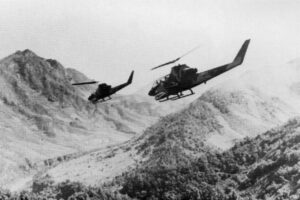9 April 1971 – The last major airmobile operation of the Vietnam war, Operation Lam Son 719, ends after North Vietnamese Army forces drive all South Vietnamese forces out of Laos with heavy casualties and the loss of multiple US aircraft, especially in US Army helicopters.
The success of the operation has been called into question. On April 7, 1971, in a “televised speech, President Nixon claimed that “Tonight I can report that Vietnamization has succeeded.” and announced the withdrawal of a further 100,000 troops from South Vietnam between May and November 1971.
At Đông Hà, South Vietnam, President Thiệu addressed the survivors of the incursion and claimed that the operation in Laos was “the biggest victory ever.”
To the North Vietnamese “the “Route 9 – Southern Laos Victory”, was viewed as a complete success.
“The number of helicopters destroyed or damaged during the operation shocked the proponents of U.S. Army aviation and prompted a reevaluation of basic airmobile doctrine. The 101st Airborne Division alone, for example, had 84 of its aircraft destroyed and another 430 damaged. During the operation, American helicopters had flown more than 160,000 sorties and 19 U.S. Army aviators had been killed, 59 were wounded and 11 were missing at its conclusion. South Vietnamese helicopters had flown an additional 5,500 missions. U.S. Air Force tactical aircraft had flown more than 8,000 sorties during the incursion and had dropped 20,000 tons of bombs and napalm. B-52 bombers had flown another 1,358 sorties and dropped 32,000 tons of ordnance. Seven U.S. fixed-wing aircraft were shot down over southern Laos: six from the Air Force (two dead/two missing) and one from the Navy (one aviator killed).
 Totally, U.S Army lost 108 helicopter destroyed (10 OH-6A, 6 OH-58, 53 UH-1H, 26 AH-1G, 3 CH-47, 2 CH-53) and another 618 damaged (25 OH-6A, 15 OH-58, 316 UH-1H, 158 AH-1G, 26 CH-47, 13 CH-53, 2 CH-54). Twenty percent of these helicopters were so badly damaged that they were not expected to fly again. This figure is excluding the number of ARVN’s helicopters lost.
Totally, U.S Army lost 108 helicopter destroyed (10 OH-6A, 6 OH-58, 53 UH-1H, 26 AH-1G, 3 CH-47, 2 CH-53) and another 618 damaged (25 OH-6A, 15 OH-58, 316 UH-1H, 158 AH-1G, 26 CH-47, 13 CH-53, 2 CH-54). Twenty percent of these helicopters were so badly damaged that they were not expected to fly again. This figure is excluding the number of ARVN’s helicopters lost.
Succinctly, it could be said that the operation as a whole failed for the Americans because of the overreliance on airpower, coupled with the inability of ground troops to operate into Laos. This then became a contributing factor in the defeat of the South Vietnamese forces, as they had planned to utilize and exploit airpower to outperform and outmaneuver the PAVN. Further communications issues, and the inability of the ARVN to properly allocate and plan resources for such a large operation no doubt compounded the problems faced in the field, which seemed not to be reported to the higher command structures, especially in Washington.”
Source: Excerpted from Wikipedia https://en.wikipedia.org/wiki/Operation_Lam_Son_719
